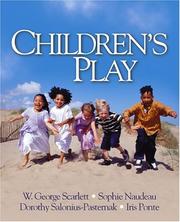| Listing 1 - 5 of 5 |
Sort by
|
Book
Year: 2012 Publisher: Washington : Banque Mondial,
Abstract | Keywords | Export | Availability | Bookmark
 Loading...
Loading...Choose an application
- Reference Manager
- EndNote
- RefWorks (Direct export to RefWorks)
Child development --- Early childhood education --- Child welfare
Book
ISBN: 0821385267 9786612906237 0821385283 1282906232 Year: 2010 Publisher: Washington, DC : World Bank,
Abstract | Keywords | Export | Availability | Bookmark
 Loading...
Loading...Choose an application
- Reference Manager
- EndNote
- RefWorks (Direct export to RefWorks)
The World Bank created this Early Child Development (ECD) Guide in response to a growing demand from Task Team Leaders (TTLs) for advice and support to facilitate the policy dialogue on the topic of ECD and to help policy makers make and implement relevant choices on how to best invest in ECD in the context of their country's economy and national priorities. This Guide fills a gap in the literature by (i) distilling existing information in a user-friendly format, (ii) providing practical information on topics that have recently become particularly relevant in ECD (e.g., measuring child develop
Child development -- Developing countries. --- Child welfare -- Developing countries. --- Early childhood education -- Developing countries. --- Child development --- Child welfare --- Early childhood education --- Social Welfare & Social Work --- Social Sciences --- Child & Youth Development --- Child study --- Children --- Development, Child --- Development --- Education --- Developmental biology --- Developmental psychobiology --- Child rearing
Book
Year: 2015 Publisher: Washington, D.C. : The World Bank,
Abstract | Keywords | Export | Availability | Bookmark
 Loading...
Loading...Choose an application
- Reference Manager
- EndNote
- RefWorks (Direct export to RefWorks)
Adolescence is a time of transitions that foster both challenges and opportunities. Indeed, choices made during adolescence not only have immediate consequences but also greatly influence the economic opportunities, health outcomes, and skill sets attained later in life, and yet it is the same period when social norms create pathways largely defined by gender. Poverty and ethnic minority status can further magnify gender discrepancies for youth worldwide, as reductions in household spending on education, health care, and nutrition are often more likely to affect adolescent girls than boys. In Zambia, adolescents make up 24% of the total population, a substantial proportion that is expected to become higher than neighboring countries if current trends continue. The high prevalence of child marriage and teenage pregnancy among Zambian girls greatly contributes to the high fertility and population growth trends, and is also closely interrelated with a range of economic and socio-cultural determinants that perpetuate a vicious cycle for the poorest and most vulnerable girls and have costly consequences for them and for the nation as a whole. In order to initiate the potential for a demographic dividend, Zambia will need to initiate a demographic transition. Reducing child marriage and teenage pregnancy can significantly contribute to the fertility declines needed to accelerate this demographic transition and would lead to better life outcomes for adolescent girls and better opportunities for the next generation. Accordingly, this series of policy briefs focuses on four key areas of interventions (or pillars) as follows: (i) maintaining girls in school; (ii) equipping out-of-school girls with skills; and (iii) beginning a family and supporting girls to adopt healthy lifestyles; and (iv) addressing the child development needs of children born to teenage mothers.
Adolescent Health --- Children and Youth --- Demographics --- Fertility --- Gender --- Health, Nutrition and Population --- Reproductive Health --- Social Development
Book
Year: 2017 Publisher: Washington, D.C. : The World Bank,
Abstract | Keywords | Export | Availability | Bookmark
 Loading...
Loading...Choose an application
- Reference Manager
- EndNote
- RefWorks (Direct export to RefWorks)
This study analyzed the impact of a community-based preschool program on child development and schooling outcomes in high-poverty areas of rural Mozambique. Preschools were randomly assigned to 30 of 76 eligible communities. Using a panel survey of 2,000 households with preschool aged children, the study found that children who attended preschool experienced gains in cognitive development, communication, fine motor skills, and socio-emotional skills, scoring 0.33 standard deviations higher on a child development screening test. Preschoolers were 21 percentage points more likely to be enrolled in primary school, 14.9 percentage points more likely to enroll at the appropriate age, and had higher cognitive and communication scores in first grade. Treatment effects were generally larger for children from vulnerable households, those with higher initial development levels, and those with longer exposure to treatment. The preschool intervention also generated positive spillovers by increasing the school enrollment of older siblings and labor supply of adult caregivers. At a cost of approximately USD 3 per child per month, community-led preschools have the potential to be a cost-effective policy option for helping children meet their development potential even in the most resource deprived parts of the world.
Early Childhood --- Early Childhood Development --- Education --- Education Finance --- Human Capital --- Poverty --- Poverty Reduction --- Preschool

ISBN: 0761929991 Year: 2005 Publisher: Thousand Oaks ; London ; New Delhi : Sage Publications,
Abstract | Keywords | Export | Availability | Bookmark
 Loading...
Loading...Choose an application
- Reference Manager
- EndNote
- RefWorks (Direct export to RefWorks)
Développement de l'enfant --- Jeu --- Psychothérapie --- Développement de l'enfant --- Psychothérapie
| Listing 1 - 5 of 5 |
Sort by
|

 Search
Search Feedback
Feedback About UniCat
About UniCat  Help
Help News
News